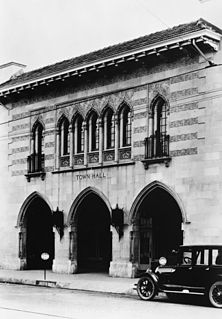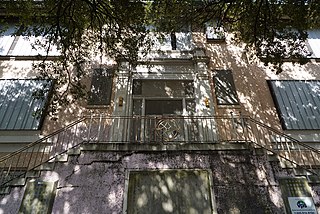Related Research Articles
Guilbert and Betelle was an architecture firm formed as a partnership of Ernest F. Guilbert and James Oscar Betelle. The firm specialized in design of schools on the East Coast of the United States, with an emphasis on the "Collegiate Gothic" style.
Thomas Wilson Williamson was a Kansas architect who specialized in designing school buildings in Kansas, Iowa, and Missouri.

Jules Jacques Benois Benedict was one of the most prominent architects in Colorado history, whose works include a number of well-known landmarks and buildings listed on the National Register of Historic Places.

August Geiger was one of the most prominent American architects in South Florida from 1905 to the late 1940s. He experimented in Mission, Neo-Renaissance and Art Deco architecture, but is most noted for his works in the Mediterranean Revival style. A number of his works are listed on the U.S. National Register of Historic Places.
Henry LeRoy Blatner (1911–1978) was an American architect.
Frederick Adolph Brinkman was an American architect based in Kalispell, Montana, and Brinkman and Lenon is a partnership in which he worked. More than a dozen of Brinkman's extant works in and around Kalispell have been listed on the National Register of Historic Places, including the Anderson Style Shop, Charles Boles House, Brice Apartments, City Water Department, Cornelius Hedges Elementary School, Russell School, Linderman School, the Montgomery Ward Store in Kalispell, and the O'Neil Print Shop.

Edward Fairfax Neild Sr., was an American architect originally from Shreveport, Louisiana, who designed the Harry S. Truman Presidential Library and Museum in Independence, Missouri. He was selected for the task by U.S. President Harry Truman.
Hyrum Conrad Pope was a German-born architect with important architectural works throughout the western United States and Canada. Pope was born in Fürth, Bavaria and immigrated to the United States as a teenager. He went to school at the Art Institute of Chicago where he was influenced in the Prairie School architectural style. In 1910, he opened an architectural firm with Harold W. Burton in Salt Lake City, Utah. Pope designed a variety of places of worship for many faiths, civic buildings and homes, some of which are listed on the National Register of Historic Places.
Frederic Hutchinson "Bunk" Porter, Sr., sometimes referred to as Frederick Hutchinson Porter, was an American architect based in Cheyenne, Wyoming. He was active from 1911 to approximately 1965. He designed many of Cheyenne's most important public and commercial buildings and also designed several buildings at the University of Wyoming, including War Memorial Stadium and the Agriculture Building. A number of his works are listed on the U.S. National Register of Historical Places.
Leon C. Goodrich was an American architect of Casper, Wyoming. A number of his works are listed on the National Register of Historic Places.

William Frantz Elementary School is an American elementary school located at 3811 North Galvez Street, New Orleans, Louisiana, 70117. Along with McDonogh No. 19 Elementary School, it was involved in the New Orleans school desegregation crisis during 1960.

Beuttler & Arnold was an architectural firm in Sioux City, Iowa that designed several works that are listed on the National Register of Historic Places for their architecture.
John F. Reynolds, usually known as J.F. Reynolds, was an architect of Sioux City, Iowa and Lincoln, Nebraska. He designed schools and courthouses. Several of his works have been listed on the National Register of Historic Places (NRHP) for their architecture.

John G. Ralston was an American architect who worked out of Waterloo, Iowa. A number of his works are listed on the U.S. National Register of Historic Places for their architecture.

The Bossier High School on Colquitt Street in Bossier City in Bossier Parish, Louisiana was built in 1923 and 1928 and was listed on the National Register of Historic Places in 1998. It later became known as Bossier City Elementary School.
Norman Foote Marsh (1871-1955) was an American architect based in Los Angeles, California who worked mostly in California and Arizona.
Ludwig O. Solberg was an architect based in Wenatchee, Washington.

The Adolph Meyer School, at 2013 General Meyer Ave. in New Orleans, Louisiana, was listed on the National Register of Historic Places in 2016.

McDonogh 19 Elementary School is an American elementary school located at 5909 St. Claude Avenue in the Lower Ninth Ward of New Orleans, Louisiana. Along with William Frantz Elementary School, it was involved in the New Orleans school desegregation crisis during 1960.
Francis Charles Woods was a Scottish-born American architect and organ-builder who designed many buildings in Utah and Idaho. Some of his works are listed on the National Register of Historic Places (NRHP), including the Hotel Brigham and the Summit County Courthouse.
References
- 1 2 3 John M. Tess (October 12, 2015). "National Register of Historic Places Registration: Adolph Meyer School / Harriet R. Tubman Elementary School" (PDF). National Park Service . Retrieved August 10, 2019. With historic photos and plans, and 16 photos from 2015.
- 1 2 Donna Fricker; Alison Bordelon (March 2005). "National Register of Historic Places Inventory/Nomination: William Frantz School / Frantz Elementary". National Park Service . Retrieved August 10, 2019. With accompanying six photos from 1994
- 1 2 3 "National Register Information System". National Register of Historic Places . National Park Service. November 2, 2013.
- ↑ Greater New Orleans Fire Photos: Orleans Parish, http://www.gnofirephotos.com/OP/E29_500_HQ.html